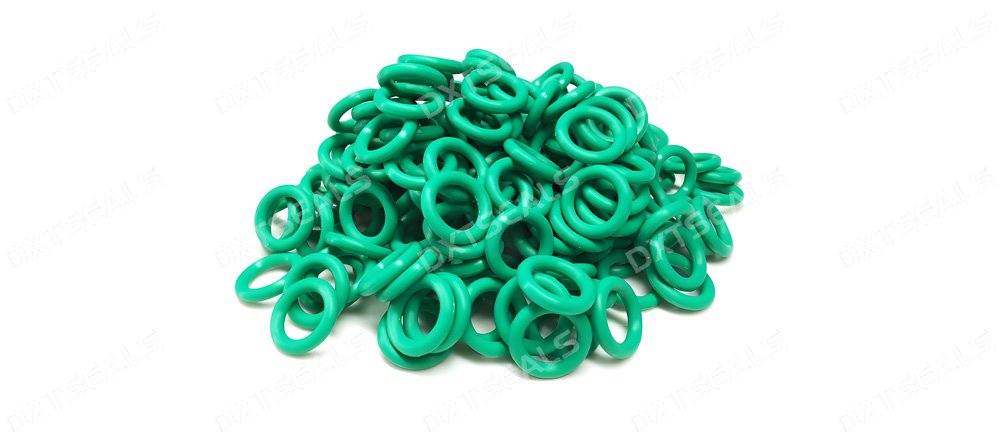
In industrial applications, O-rings are essential components that provide effective sealing solutions in environments with high temperatures, aggressive chemicals, and extreme conditions. Choosing the right material for your O-rings can ensure the durability, performance, and safety of your equipment. In this article, we’ll explore the best O-ring materials for high-temperature and chemical-resistant applications, focusing on Viton, EPDM, and NBR.
1. Viton O-Rings: The Ultimate Solution for High-Temperature and Chemical Resistance
Viton (FKM) O-rings are known for their exceptional resistance to extreme temperatures and aggressive chemicals. Here's why Viton is often considered the top choice for demanding industrial applications:
-
High-Temperature Tolerance: Viton O-rings can withstand temperatures up to 250°C, making them ideal for high-heat environments like engines, chemical reactors, and aerospace applications.
-
Chemical Resistance: Viton offers outstanding resistance to a wide range of chemicals, including acids, fuels, solvents, and oils. This makes it the material of choice for sealing in the oil and gas, automotive, and chemical industries.
-
Durability and Longevity: Viton O-rings are known for their long lifespan, even under harsh conditions. Their resistance to aging, ozone, and UV exposure ensures that Viton seals maintain their integrity over time.
-
Versatility: Due to its high-performance capabilities, Viton is used in a variety of industries, including pharmaceuticals, automotive, and petrochemical sectors.
2. EPDM O-Rings: Perfect for Water, Steam, and Outdoor Applications
EPDM (Ethylene Propylene Diene Monomer) O-rings are an excellent choice when the application involves exposure to water, steam, and environmental elements. Here’s why EPDM O-rings excel in chemical and temperature resistance:
-
Excellent Weather Resistance: EPDM O-rings are highly resistant to UV radiation, ozone, and outdoor elements, making them suitable for applications in outdoor equipment and automotive parts exposed to the weather.
-
Water and Steam Resistance: EPDM is also known for its resistance to water, steam, and polar solvents, making it ideal for sealing in water treatment systems, HVAC systems, and plumbing applications.
-
Temperature Range: EPDM O-rings can withstand temperatures from -50°C to 150°C, making them versatile enough for both cold and hot environments.
-
Good Mechanical Properties: EPDM provides excellent flexibility, resilience, and tensile strength, ensuring that it can maintain a reliable seal in various industrial settings.
3. NBR O-Rings: Reliable Sealing for Oil and Fuel Systems
Nitrile Butadiene Rubber (NBR) O-rings are widely used in applications involving petroleum-based products, such as oils and fuels. These are the key advantages of NBR O-rings for high-temperature and chemical-resistant environments:
-
Oil and Fuel Resistance: NBR O-rings are well-known for their ability to resist oils, fuels, and other petroleum-based products. They are widely used in automotive, aviation, and hydraulic systems where such fluids are common.
-
Wide Temperature Range: NBR O-rings can typically withstand temperatures ranging from -40°C to 120°C, making them ideal for moderate temperature applications.
-
Mechanical Strength: NBR O-rings offer good tensile strength and wear resistance, providing a reliable seal under pressure and during high-stress operations.
-
Affordable and Versatile: NBR is cost-effective, making it a popular choice for general-purpose sealing solutions in industries that work with fuels, oils, and other lubricants.
4. Other Materials for High-Temperature and Chemical Resistance
While Viton, EPDM, and NBR are the most common O-ring materials for high-temperature and chemical-resistant applications, other materials such as Silicone (VMQ) and Perfluoroelastomer (FFKM) may also be suitable for specific uses:
-
Silicone O-Rings: Best for high and low temperatures, silicone O-rings are commonly used in the food and medical industries but have limitations with chemical resistance.
-
Perfluoroelastomer (FFKM) O-Rings: For extreme chemical and temperature resistance, FFKM O-rings are used in high-performance applications, especially in the chemical and pharmaceutical industries.
5. Choosing the Best O-Ring Material for Your Application
Selecting the right O-ring material depends on several factors, including:
-
Temperature Resistance: For high-temperature applications, Viton is the best choice. EPDM can handle moderate temperatures, and NBR is more suitable for standard conditions.
-
Chemical Exposure: If your application involves aggressive chemicals, Viton or FFKM is the ideal material. EPDM handles water and steam, while NBR is designed for oils and fuels.
-
Mechanical Properties: Consider the stress and pressure the O-ring will face. NBR and Viton are known for their mechanical strength, while EPDM offers excellent flexibility.
-
Cost and Availability: While Viton and FFKM O-rings offer superior performance, they are more expensive than NBR and EPDM, which may be more cost-effective for general-purpose applications.
6. Conclusion
O-rings made from Viton, EPDM, and NBR are the most reliable and commonly used sealing solutions in industrial applications that require high-temperature and chemical resistance. Viton excels in extreme conditions with high chemical and temperature resistance, while EPDM is ideal for water and steam resistance, and NBR is best for oil and fuel applications. By understanding the unique properties of these materials, you can choose the best O-ring for your specific industrial needs, ensuring reliable performance and reducing the risk of seal failure.
